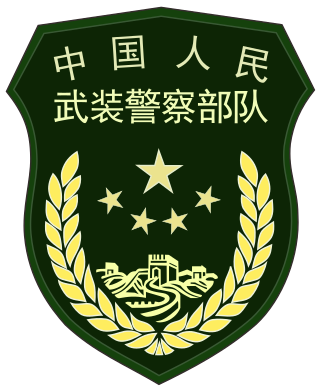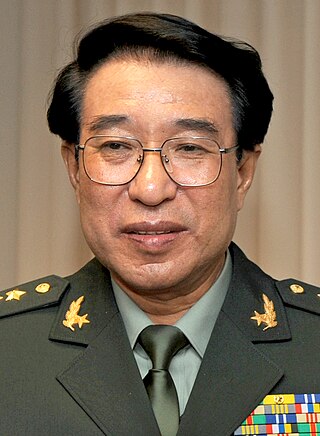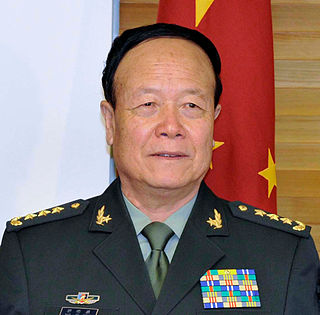
The People's Liberation Army (PLA) is the principal military force of the People's Republic of China and the armed wing of the Chinese Communist Party (CCP). The PLA consists of five service branches: the Ground Force, Navy, Air Force, Rocket Force, and Strategic Support Force. It is under the leadership of the Central Military Commission (CMC) with its chairman as commander-in-chief.

The Chinese People's Armed Police Force is a Chinese paramilitary organization primarily responsible for internal security, riot control, counter-terrorism, disaster response, law enforcement and maritime rights protection as well as providing support to the People's Liberation Army (PLA) during wartime.

The Central Military Commission (CMC) is the highest national defense organization in the People's Republic of China, which heads the People's Liberation Army (PLA), the People's Armed Police (PAP), and the Militia of China.

Paramount leader is an informal term for the most important political figure in the People's Republic of China (PRC). The paramount leader typically controls the Chinese Communist Party (CCP) and the People's Liberation Army (PLA), often holding the titles of CCP General Secretary and Chairman of the Central Military Commission (CMC). The head of state (president) or head of government (premier) are not necessarily paramount leader—under China's party-state system, CCP roles are politically more important than state titles.

Xu Caihou was a Chinese general in the People's Liberation Army (PLA) and vice-chairman of the Central Military Commission (CMC), the country's top military council. As Vice-chairman of the CMC, he was one of the top ranking officers of the People's Liberation Army. He also held a seat on the 25-member Politburo of the Chinese Communist Party between 2007 and 2012.

The People's Liberation Army Rocket Force, formerly the Second Artillery Corps, is the strategic and tactical missile force of the People's Republic of China. The PLARF is the 4th branch of the People's Liberation Army (PLA) and controls China's arsenal of land-based ballistic missiles—both nuclear and conventional. The armed service branch was established on 1 July 1966 and made its first public appearance on 1 October 1984. The headquarters for operations is located at Qinghe, Beijing. The PLARF is under the direct command of the Chinese Communist Party's Central Military Commission (CMC).

The Government of the People's Republic of China is an authoritarian one-party political system in the People's Republic of China under the exclusive political leadership of the Chinese Communist Party (CCP). It consists of legislative, executive, military, supervisory, judicial, and procuratorial branches. The constitutional head of government is the premier, while the de facto top leader of government is the CCP general secretary.

In the People's Republic of China, theater commands are joint commands responsible for developing strategy, plans, tactics, and policy specific to their assigned area of responsibility. Currently, the PRC subdivides the nation into five theater commands, Eastern, Southern, Western, Northern, and Central to provide the Central Military Commission (CMC) of the Chinese Communist Party (CCP) extensive, though not exclusive, command authority over the assigned region.
The military modernization program of the People's Liberation Army (PLA) which began in the late 1970s had three major focuses. First, under the political leadership of 3rd paramount leader Deng Xiaoping, the military became disengaged from civilian politics and, for the most part, resumed the political quiescence that characterized its pre-Cultural Revolution role. Deng reestablished civilian control over the military by appointing his supporters to key military leadership positions, by reducing the scope of the PLA's domestic non-military role, and by revitalizing the party political structure and ideological control system within the PLA.

Guo Boxiong is a former general of the People's Liberation Army of China. He served as the Vice Chairman of the Central Military Commission, China's top military council, between 2002 and 2012. During the same period he also held a seat in the Politburo of the Chinese Communist Party, China's top decision-making body. He was expelled from the Communist Party on 30 July 2015. On July 25, 2016, he was sentenced to life imprisonment for bribery.
The National security of China is the coordination of a variety of organizations, including law enforcement, military, paramilitary, governmental, and intelligence agencies that aim to ensure China's national security. China considers three factors in its national security: national sovereignty, security, and development interests.

Zhang Youxia is a Chinese general in the People's Liberation Army (PLA) and currently the first-ranked Vice Chairman of the Central Military Commission (CMC). He previously served as Head of the CMC Equipment Development Department, and its predecessor, the PLA General Armaments Department, from 2012 to 2017. He is the son of General Zhang Zongxun. He is a veteran of the 1979 Sino-Vietnamese War and one of the few serving generals in China with war experience.

Li Zuocheng is a general of the People's Liberation Army (PLA) of China. He was chief of the Joint Staff Department of the Central Military Commission from 2017 to 2022. Between 2015 and 2017, he served as the inaugural Commander of the PLA Ground Force. A veteran of the Sino-Vietnamese War, he served in southern China for most of his career and was commander of the Chengdu Military Region between 2013 and 2016.

The president of the People's Republic of China, commonly called the president of China, is the head of state and the second-highest political office of the People's Republic of China. The presidency is a ceremonial office and not the role with the real power in China's political system. However, the post has been held by the general secretary of the Chinese Communist Party and chairman of the Central Military Commission since 1993, who is China's de facto leader.

The People's Liberation Army Strategic Support Force is the space, cyber, political, and electronic warfare force and the 5th branch of the People's Liberation Army (PLA). It was established in December 2015 as part of the first wave of the Chinese military reforms.

The Joint Staff Department of the Central Military Commission (JSDCMC) is the command organ and the headquarters for the People's Liberation Army (PLA), superseding the former PLA General Staff Department (GSD). It was established on 11 January 2016, under the military reforms of Central Military Commission (CMC) chairman Xi Jinping.

The Eastern Theater Command is one of the five theater commands of the People's Liberation Army (PLA), founded 1 February 2016. It replaced the Nanjing Military Region. The command is headquartered in Nanjing.

The 70th anniversary of the founding of the People's Republic of China was observed with a series of ceremonial events including a grand military parade as its spotlight to celebrate National Day of the People's Republic of China that took place on 1 October 2019 in Beijing. It was the largest military parade and mass pageant in Chinese history.
The Intelligence Bureau of the Joint Staff Department of the Central Military Commission is one of the People's Republic of China's primary intelligence organizations and the principal military intelligence organ of the People's Liberation Army (PLA).
A military unit cover designator is a unique five-digit number used by the People's Liberation Army of the People's Republic of China to externally identify military units. MUCDs are used externally to protect the identity of units, while a true unit designator is used internally as they plainly identify the unit and its function.
















